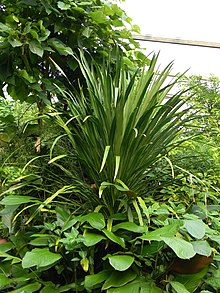
Wollemia is a genus of coniferous trees in the family Araucariaceae, endemic to Australia. It represents only one of three living genera in the family, alongside Araucaria and Agathis. The genus only has a single known species, Wollemia nobilis, commonly known as the Wollemi Pine which was discovered in 1994 in a temperate rainforest wilderness area of the Wollemi National Park in New South Wales. It was growing in a remote series of narrow, steep-sided, sandstone gorges 150 km (93 mi) north-west of Sydney. The genus is named after the National Park.
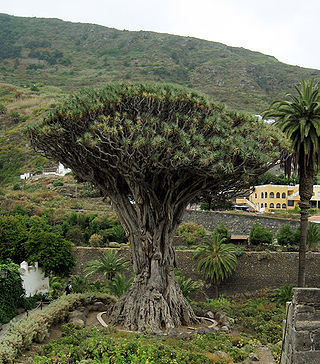
Dracaena is a genus of about 120 species of trees and succulent shrubs. The formerly accepted genera Pleomele and Sansevieria are now included in Dracaena. In the APG IV classification system, it is placed in the family Asparagaceae, subfamily Nolinoideae. It has also formerly been separated into the family Dracaenaceae or placed in the Agavaceae.
Takhtajania is a genus of flowering plants of the family Winteraceae, which contains a single species, Takhtajania perrieri. It is endemic to Madagascar.

Dracaena draco, the Canary Islands dragon tree or drago, is a subtropical tree in the genus Dracaena, native to the Canary Islands, Cape Verde, Madeira, western Morocco, and possibly introduced into the Azores.

Sophora toromiro, commonly known as toromiro, is a species of flowering tree in the legume family, Fabaceae, that is endemic to Easter Island.

Corypha umbraculifera, the talipot palm, is a species of palm native to eastern and southern India and Sri Lanka. It is also grown in Cambodia, Myanmar, Thailand, Mauritius and the Andaman Islands. It is one of the five accepted species in the genus Corypha. It is a flowering plant with the largest inflorescence in the world. It lives up to 60 years before bearing flowers and fruits. It dies shortly after.

Dracaena reflexa is a tree native to Mozambique, Madagascar, Mauritius, and other nearby islands of the Indian Ocean. It is widely grown as an ornamental plant and houseplant, valued for its richly coloured, evergreen leaves, and thick, irregular stems.
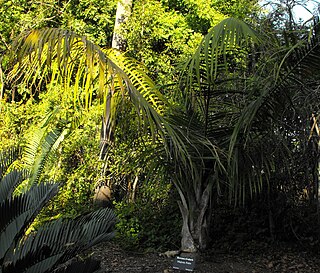
Ravenea is a genus of 20 known species of palms, all native to Madagascar and the Comoros.
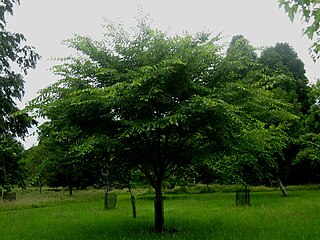
Ulmus davidiana, also known as the David elm, or Father David elm, is a small deciduous tree widely distributed across China, Mongolia, Korea, Siberia, and Japan, where it is found in wetlands along streams at elevations of 2000–2300 m (6,500–7,500 ft). The tree was first described in 1873 from the hills north of Beijing, China.

The Field Elm cultivar Ulmus minor 'Umbraculifera' [:shade-giving] was originally cultivated in Iran, where it was widely planted as an ornamental and occasionally grew to a great size, being known there as 'Nalband' Persian: نعلبند [:the tree of the farriers]. Litvinov considered it a cultivar of a wild elm with a dense crown that he called U. densa, from the mountains of Turkestan, Ferghana, and Aksu. Non-rounded forms of 'Umbraculifera' are also found in Isfahan Province, Iran. Zielińksi in Flora Iranica considered it an U. minor cultivar.

The Field Elm cultivar Ulmus minor 'Umbraculifera Gracilis' was obtained as a sport of 'Umbraculifera' by the Späth nursery of Berlin c.1897. It was marketed by the Späth nursery in the early 20th century, and by the Hesse Nursery of Weener, Germany, in the 1930s.
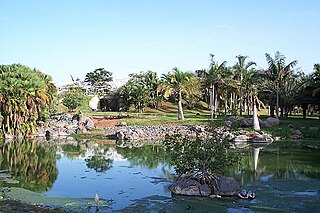
The Palmetum of Santa Cruz de Tenerife is a botanical garden of 120,000 m2 specialized in palms (Arecaceae). It is an artificial hill, with views of the ocean, located in Santa Cruz de Tenerife, Canary Islands, Spain. The gardens include a large system of waterfalls, streams and ponds, a museum dedicated to palms, and a display shade house. The project was started in 1995 on a former landfill and only opened to the public in 2014. The valuable palm collection gathers about 600 species of palms and it is focused on the ones native to world islands. Trees and shrubs of other plant families are also displayed, organised in "biogeographical sections". All gardens are maintained with no pesticides and no fertilizers, different species of wild birds are easily seen in the palmetum.
Philip Burnard Ayres (1813–1863) was a British physician, botanist and plant collector. He was born at Thame in Oxfordshire on 12 December 1813. He initially began to collect plants in his native United Kingdom and also in France. Between 1841 and 1845 he issued three exsiccata-like series, among them Mycologia Britannica or specimens of British fungi and with William Baxter another exsiccata under the title Flora Thamnensis. In 1856 Ayres was appointed by Queen Victoria to superintendency of quarantine on Flat Island, Mauritius under governor Robert Townsend Farquhar. Ayres is particularly well known for his extensive plant collections made while in this position. He is also credited for finding the first sub fossil remains of the dodo in 1860. From 1856 to 1863 he traveled through Madagascar, the Seychelles, and the Mascarenes to develop this rich collection of Indian Ocean plant specimens. These specimens are now in the herbaria collections of the Natural History Museum, London, the Royal Botanic Garden Edinburgh, the Royal Botanic Gardens, Kew, the Missouri Botanical Garden and the Muséum National d'Histoire Naturelle, Paris. In addition to collecting, Ayres catalogued and sketched the plants in the wild, as was common among nineteenth century naturalists. He also planned to write a book about the flora of Mauritius, but he died from relapsing fever in his home in Port Louis on 30 April 1863 before the flora could be accomplished. Ayres' wife Harriet collected his written records and bequeathed them to the Royal Botanic Gardens, Kew.
Ulmus boissieriGrudz.,, a disputed species of elm found in Iran, was identified by Grudzinskaya in 1977. She equated her "new species" with the U. campestris f. microphylla collected in 1859 in Kerman Province and described in his Flora Orientalis (1879) by Boissier, for whom she named it, treating Boissier's specimen as the "type". The tree is endemic the provinces of Kermanshah and Kerman., and also the Zagros forests, growing with Quercus brantii, Celtis australis, Platanus orientalis, Fraxinus sp., and Cerasus mahaleb.

Cylindrocline lorencei is a small tree that was native to the island of Mauritius, with only one specimen ever observed in the wild. By 1990 the species was considered extinct, and the only available seed could not be germinated. Brest Botanic Gardens successfully performed in vitro culture of a viable part of the seed embryo, saving the plant from extinction. Through further vegetative propagation at Brest and Kew Botanic Gardens, a small population of Cylindrocline lorencei has been grown and efforts are now underway to re-establish it in its native habitat.

Eucommia is a genus of small trees now native to China, with a fossil record that shows a much wider distribution. The single living species, Eucommia ulmoides, is near threatened in the wild, but is widely cultivated in China for its bark, and is highly valued in herbology such as traditional Chinese medicine.

The Stellenbosch University Botanical Garden located in the historical center of Stellenbosch is the oldest university botanical garden in South Africa. The Garden is relatively small and houses an enormous diversity of plants, both indigenous to South Africa and introduced species. It is open to the public.
Hesperelaea is a plant genus with only one species, probably now extinct. Hesperelaea palmeri was found only on Guadalupe Island, a small island in the Pacific Ocean, part of the Mexican state of Baja California, about 400 km (250 mi) southwest of Ensenada. The last collection of the plant on the island was in 1875, so the species and the genus must now be presumed extinct. An intensive search for the plant in 2000 was unsuccessful.
Schizolaena isaloensis is a tree in the family Sarcolaenaceae. It is endemic to Madagascar. The specific epithet refers to Isalo National Park, near where the species was identified.

Dracaena tamaranae, or drago de Gran Canaria, is a species of flowering plant endemic to the island of Gran Canaria, related to the dragon tree, Dracaena draco, and other species of Dracaena from East Africa. Since 1972, specimens of dragon tree have been identified in Gran Canaria with certain peculiarities. These were initially identified as specimens of Dracaena draco. However, a more detailed study concluded that it corresponded to a new species.
